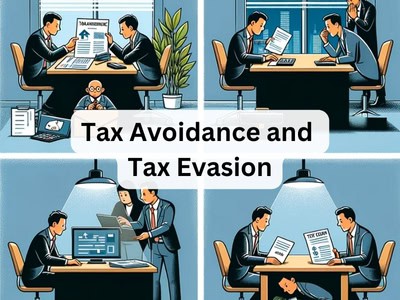This post is also available in:
![]() 简体中文 (Chinese (Simplified))
简体中文 (Chinese (Simplified))
Tax Avoidance and Tax Evasion
 Nobody enjoys paying taxes. But taxes are the law. The terms “tax avoidance” and “tax evasion” are often used interchangeably, but they are very different concepts. Basically, tax avoidance is legal while tax evasion is not.
Nobody enjoys paying taxes. But taxes are the law. The terms “tax avoidance” and “tax evasion” are often used interchangeably, but they are very different concepts. Basically, tax avoidance is legal while tax evasion is not.
Tax avoidance arrangement
A tax avoidance arrangement normally involves an arrangement that is artificial, contrived or has little or no commercial substance and is designed to obtain a tax advantage that is not intended by Parliament.
Tax evasion
Tax evasion is a criminal offence which involves the reduction of one’s tax liability or obtainment of tax credits or refunds through illegal means such as the claim for fictitious or non-existent expense and the failure to declare taxable income.
Anti-avoidance
In Singapore, the general anti-avoidance provision is found in Section 33 of the Singapore Income Tax Act, which was enacted to curb the proliferation of blatant tax avoidance arrangements in Singapore. Section 33 empowers the Comptroller of Income Tax (“CIT”) to disregard and make relevant adjustments to arrangements which are carried out with tax avoidance as one of their main purposes and not for bona fide commercial reasons.
Bona fide commercial transactions which are carried out not in pursuance of any tax avoidance arrangement will not come within the scope of Section 33. Companies and individuals granted tax exemptions and concessions under specific tax provisions would not be affected by Section 33, provided that no artificiality or contrivance exists to exploit the exemptions or concessions intended by the Parliament.
To provide clarity and guidance on the types of arrangements which in CIT’s view would have the purpose of effect of tax avoidance within the meaning of Section 33(1) of the Singapore Income Tax Act, the examples in this section have been categorised into broad categories which contain a hallmark of tax avoidance. They are:
- Circular flow or round-tripping of funds;
- Set-up of more than one entity for the sole purpose of obtaining tax advantage;
- Changes in the form of business entity for the sole purpose of obtaining tax advantage; and
- Attribution of income that is not aligned with economic reality.
Section 33 is aimed at tax avoidance schemes designed to avoid tax and is not intended to interfere with the tax consequences of genuine commercial transactions. For example, (i) the placement of monies in a local bank or with a bank outside Singapore, (ii) the provision of housing accommodation to employees directly instead of giving a taxable housing allowance or (iii) the non-remittance of foreign income, is not intended to be the subject of the CIT’s exercise of his section 33(1) powers.
Tax planning
In view of the above, it is essential for legitimate tax planning to stay within the language and spirit of the law. Transactions must have been carried out for commercial reasons and not have the avoidance or reduction of tax as one of its main purposes.
At 3E Accounting Pte Ltd, we work closely with you to identify tax strategies that work best within your organisation and manage your tax compliance.
Contact us today for Corporate Income Tax Planning at [email protected] for a no-obligation consultation!


